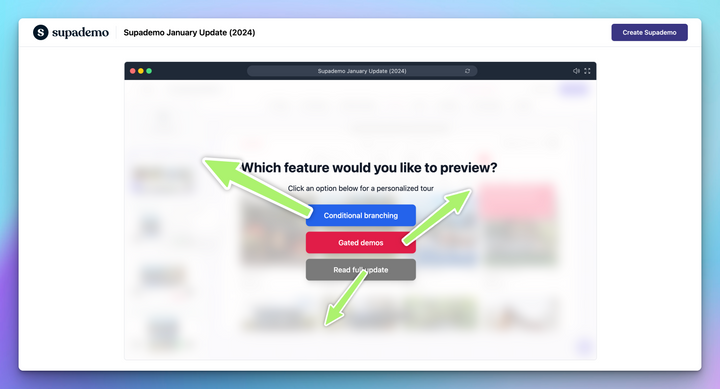In the world of sales, having a well-defined and efficient sales process is essential for achieving consistent success. A sales process serves as a roadmap, guiding your sales team through the various stages of a sale and helping them close deals effectively. In this comprehensive guide, we will explore the importance of a sales process, break down its key components, and provide insights on how to create a winning sales process for your business. As a Growth Marketer at Supademo, I'm excited to share how interactive demos and guides can enhance your sales process at each stage.
Q1: Why is it important for businesses to have a well-defined sales process?
- The Significance of a Sales Process
A sales process is a systematic approach to selling that defines the steps your sales team should follow when interacting with potential customers. It provides a structured and repeatable framework for achieving sales goals. The key components of an effective sales process include:
- Stages: The process is divided into clear and defined stages, each representing a specific phase in the sales journey.
- Actions: For each stage, there are recommended actions or activities to guide sales representatives on what to do.
- Criteria: Clear criteria are set for moving from one stage to the next, ensuring that the progression is based on measurable indicators.
- Tools and Resources: The process is supported by tools, resources, and technology to streamline sales activities.
- The Benefits of a Sales Process
A well-defined sales process offers a range of benefits for businesses, including:
- Consistency: It ensures that all sales representatives follow a standardized approach, resulting in consistent customer experiences.
- Efficiency: Sales processes help teams work more efficiently, reducing wasted time and resources.
- Data-Driven Decision-Making: By tracking the progress of deals through the stages, businesses can make data-driven decisions to optimize the process.
- Training and Onboarding: New sales representatives can quickly get up to speed with a structured process in place.
- The Components of a Sales Process
A typical sales process consists of several stages, with each stage representing a specific phase in the sales journey. While the exact number and names of these stages may vary depending on your business and industry, here are the fundamental components:
- Prospecting: The initial stage involves identifying potential customers or leads who may have an interest in your product or service.
- Initial Contact: This is where you make the first outreach to the prospect, whether through email, phone calls, or social media.
- Qualification: Qualifying leads involves assessing whether the prospect is a good fit for your product or service based on criteria like budget, need, and timeline.
- Needs Analysis: In this stage, you explore the prospect's needs, challenges, and pain points to understand how your offering can provide value.
- Presentation and Demonstration: You present your product or service, often using interactive demos and guides created with Supademo, to showcase its features and benefits.
- Handling Objections: It's common for prospects to have objections or concerns, and this stage involves addressing these and providing solutions.
- Closing the Deal: This is the final stage where you ask for the sale and guide the prospect through the decision-making process.
- Creating Your Sales Process
To create a sales process that aligns with your business goals, consider the following steps:
a. Define Your Ideal Customer: Start by defining your ideal customer profile. This will help you understand who your target audience is and what their needs are.
b. Segment Your Leads: Segment your leads based on characteristics like industry, company size, and behavior. This allows for more personalized outreach.
c. Map the Stages: Create a visual representation of your sales process, including the stages, actions, and criteria for moving from one stage to the next.
d. Identify Key Actions: Define the key actions or activities that need to take place at each stage. For example, in the "Needs Analysis" stage, you might conduct a thorough needs assessment.
e. Set Criteria: Establish clear criteria for moving prospects from one stage to the next. For example, you may require that a prospect has a budget in place to move from "Qualification" to "Needs Analysis."
f. Select Supporting Tools: Identify the tools and resources that will support your sales process. This may include a CRM system, marketing automation, and interactive demo creation tools like Supademo.
g. Training and Onboarding: Ensure that your sales team is trained on the sales process and understands their roles and responsibilities at each stage.
- The Role of Supademo in the Sales Process
Supademo can be a powerful asset throughout the sales process:
- Prospecting: Use interactive product demos or guides in lead generation efforts to engage potential customers.
- Initial Contact: Send personalized interactive content to capture the lead's interest.
- Presentation and Demonstration: Create hands-on product demos to showcase the features and benefits of your product effectively.
- Handling Objections: Use interactive guides to address common objections and provide solutions.
- Closing the Deal: An interactive demo can be the final push a lead needs to make a purchasing decision.
- Sales Process Best Practices
To create an effective sales process and ensure its success, consider the following best practices:
- Alignment with Customer Journey: Ensure that your sales process aligns with the typical customer journey, guiding prospects from awareness to purchase.
- Regular Review and Optimization: Continuously review and optimize your sales process based on performance data and feedback.
- Cross-Functional Collaboration: Encourage cross-functional collaboration between sales, marketing, and customer success teams to ensure consistency.
- Training and Development: Invest in the training and development of your sales team to ensure they are well-equipped to follow the process.
- Feedback Loop: Create a feedback loop where sales representatives can provide insights and recommendations for process improvement.
- The Customer-Centric Approach
A customer-centric sales process prioritizes the needs and preferences of the customer. This approach involves:
- Listening Actively: Pay close attention to what the prospect is saying, ask questions, and show empathy.
- Customizing Solutions: Tailor your solutions to address the specific needs and challenges the prospect has expressed.
- Providing Value: Demonstrate how your product or service provides value and solutions to the prospect's pain points.
- Consistent Follow-Up: Maintain consistent and timely follow-up with prospects to provide information and address their concerns.
Conclusion
In conclusion, a well-defined and efficient sales process is the backbone of successful sales efforts. By breaking down the sales journey into stages, defining key actions, setting criteria, and leveraging supporting tools, businesses can streamline their sales activities and achieve consistent results.
Supademo, with its interactive demos and guides, can enhance the sales process by providing engaging and informative content that resonates with potential customers. By using interactive tools, you can create a hands-on experience that showcases the value of your product or service at every stage of the process.
As you embark on creating your sales process, remember to keep it customer-centric and continuously adapt and refine it to meet the evolving needs and preferences of your target audience. With a well-defined sales process and the right tools in place, you can drive your sales team towards success and achieve your sales goals.




